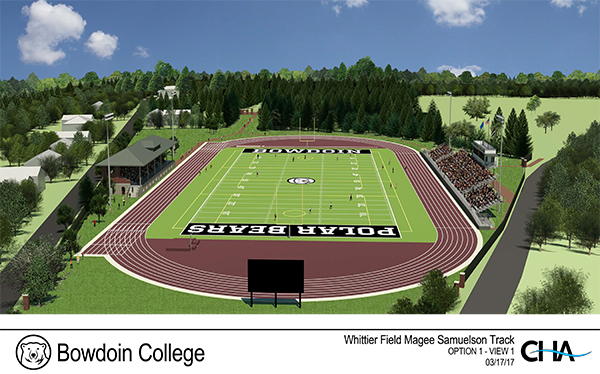Bowdoin Announces Renovations to Historic Whittier Field and Magee-Samuelson Track
By Doug CookBowdoin College today announced plans to renovate historic Whittier Field, one of the most storied football venues in the nation, and Magee-Samuelson Track, named partially in honor of Olympic champion, Maine native, and Bowdoin graduate Joan Benoit Samuelson ’79.
The initial $4.5-million phase of the project, approved in March by the Bowdoin College Board of Trustees, is scheduled to begin in early May 2017. It includes plans for replacing the existing grass field with artificial turf and adding lights, seating, and a new press box, along with an expansion of the current six-lane track to the eight lanes required to host championship track meets. It also includes a restoration of the original footprint of Hubbard Grandstand through the removal of bleachers that were added over the years to the perimeter of the structure. This will allow the straight-away lanes on the starting side to abut the edge of the grandstand, as originally intended.

The College, which began planning for the project in the summer of 2016, is working to complete this first phase by mid-September to enable the football team to use the facility for the 2017-2018 season, rather than waiting another year for the improvements.
Plans for a second $3.5-million phase call for construction of a one-story support building that will house locker, training, and equipment rooms and public restrooms. Bowdoin trustees are expected to review and vote on the second phase of the project when they meet in May. If approved, this phase of the project is expected to be completed by fall 2018.
The total $8.0 million cost for both phases of the project will be funded entirely through private donations from several individuals. The College will continue ongoing fundraising efforts through the remainder of the project, which will maintain the historic Hubbard Grandstand as a focal point of one of the oldest college football and track sites in the country.
“We are tremendously grateful to our donors, without whom this needed upgrade and renovation would not be possible,” said Bowdoin President Clayton Rose. “These iconic venues are steeped in athletic history, where sports fans from the College and Brunswick communities have gathered for generations to cheer on the Polar Bears. We have a responsibility to preserve this treasured legacy while also ensuring that the field, track, and related facilities continue to serve the needs of our athletes and athletic programs well into the 21st century.”
Whittier Field was built in 1896 in honor of Dr. Frank Nathaniel Whittier (Class of 1885), whose varied career at Bowdoin from 1886 to 1921 included serving as a lecturer in hygiene, professor in the Medical School of Maine, director of physical training, and later as college physician. Hubbard Grandstand, a gift of Civil War General Thomas H. Hubbard (Class of 1857), was completed in 1904. Bowdoin’s outdoor all-weather track was built in 1970 in honor of legendary track coach Jack Magee, who led the Polar Bears from 1913 until his retirement in 1955.
The complex was the site of an Olympic training camp that brought Bruce Jenner, Steve Prefontaine, Frank Shorter H’16, and other US Olympic track teammates to train on Magee Track before departing for the 1972 Munich Olympics.
The track was rededicated the Magee-Samuelson Track in 2005 in honor of 1984 Olympic marathon champion Joan Benoit Samuelson ’79, who captured the gold medal at the first women’s marathon at the 1984 Olympic games in Los Angeles.
The completed project will allow the renovated facility to serve as the home field for the football, men’s lacrosse, and outdoor track and field teams. The facility has also been designed for potential use by Bowdoin’s women’s lacrosse team, the men’s and women’s soccer teams, and numerous club and intramural programs.
The addition of the support building will enable the football and men’s lacrosse teams to practice at Whittier Field, relieving stress on Farley Field House and Pickard fields—where practices have been held—to make these facilities more available during the fall and spring seasons. It will also free up locker room space at Watson Arena and Pickard Field House during season overlaps.
“This exciting and long overdue project will have a direct year-round impact on the experience of our varsity athletes, on their fans, and on the hundreds of students who participate in club and intramural sports,” said Tim Ryan ’98, Bowdoin’s Ashmead White Director of Athletics. “We are deeply grateful for the contributions of alumni, parents, and friends who are making these improvements possible for the College.”
The project is being designed by the architectural firm CHA Consulting of Concord, Mass. Clark Companies, of Delhi, N.Y., has been contracted for the construction.